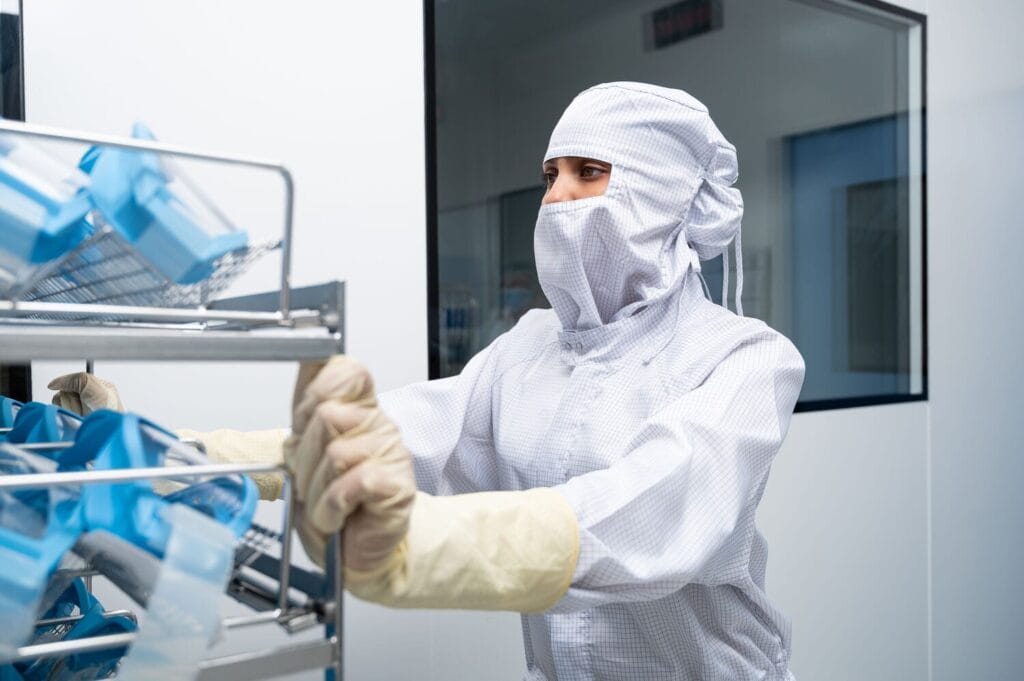
What Is the Difference Between ISO Class 5 and ISO Class 6 Cleanrooms?
The primary difference between ISO Class 5 and ISO Class 6 cleanrooms lies in their permissible particle concentration levels. ISO Class 5 environments allow a maximum of 3,520 particles per cubic metre at ≥0.5µm, while ISO Class 6 permits up to 35,200 particles per cubic metre at the same size threshold—a tenfold increase. This distinction significantly impacts contamination control capabilities, with ISO Class 5 offering substantially stricter requirements for air change rates, filtration systems, and cleanroom garment protocols. These differences directly influence which classification is appropriate for specific manufacturing processes, particularly in pharmaceutical, electronics, and medical device industries where contamination control is crucial.
What are ISO cleanroom standards?
ISO cleanroom standards are internationally recognized guidelines defined by ISO 14644-1 that establish classification criteria for cleanrooms based on airborne particulate cleanliness. These cleanroom classification standards provide a numerical designation (ISO Class 1 through ISO Class 9) that indicates the maximum allowable concentration of particles per cubic meter of air at specified particle sizes.
The ISO 14644-1 standard, first published in 1999 and revised in 2015, replaced earlier standards like the US Federal Standard 209E. It creates a consistent global framework for classifying controlled environments where airborne contamination must be minimised. The classification is determined by measuring particles at various sizes (typically 0.1µm to 5.0µm) using specialised particle counters.
Each ISO class specifies the maximum number of particles allowed per cubic meter of air:
- ISO Class 1: The cleanest classification with extremely stringent limits
- ISO Class 9: The least stringent classification
These standards are crucial for industries where product integrity, safety, or functionality depends on minimising contamination. They establish verifiable cleanliness levels, enabling consistent quality control, regulatory compliance, and operational efficiency in sensitive manufacturing environments.
| ISO Class | Maximum particles per cubic metre ≥0.1µm | Maximum particles per cubic metre ≥0.5µm | Cleanliness Level |
|---|---|---|---|
| ISO 1 | 10 | N/A | Extremely high (semiconductor wafer manufacturing) |
| ISO 5 | 100,000 | 3,520 | Very high (aseptic pharmaceutical processing) |
| ISO 6 | 1,000,000 | 35,200 | High (medical device assembly) |
| ISO 9 | N/A | 35,200,000 | Basic (general manufacturing) |
What is the difference between ISO Class 5 and ISO Class 6 cleanrooms?
The primary distinction between ISO Class 5 and ISO Class 6 cleanrooms is their particle concentration limits. ISO Class 5 environments permit a maximum of 3,520 particles per cubic meter at ≥0.5µm, while ISO Class 6 allows up to 35,200 particles at the same size—precisely ten times more particulate matter.
This fundamental difference drives several key operational variations:
- Air Change Rate: ISO Class 5 typically requires 40-60 air changes per hour, while ISO Class 6 needs 20-40 changes. This means Class 5 environments completely replace their air volume more frequently.
- Filtration Systems: Class 5 cleanrooms generally require HEPA filters with 99.997% efficiency at 0.3µm, often with terminal HEPA coverage of 40-100% of ceiling area. Class 6 environments may use less ceiling coverage (25-40%) while maintaining high-efficiency filtration.
- Air Flow Patterns: Class 5 environments typically employ unidirectional (laminar) airflow in critical areas, while Class 6 may utilise non-unidirectional (turbulent) airflow patterns.
- Recovery Time: Class 5 cleanrooms must recover from contamination events more quickly, typically within 15-20 minutes compared to 20-30 minutes for Class 6.
- Monitoring Requirements: Class 5 requires more frequent particle monitoring and stricter environmental controls than Class 6.
The pressure differential requirements also differ, with ISO Class 5 environments typically maintaining 15-20 Pascals positive pressure relative to adjacent spaces, while Class 6 may maintain 10-15 Pascals. These differences directly impact contamination control capabilities and are reflected in construction requirements, operational protocols, and maintenance procedures.
Which industries use ISO Class 5 vs. ISO Class 6 cleanrooms?
Industries requiring ISO Class 5 and Class 6 cleanrooms vary based on process sensitivity and contamination risk tolerance. ISO Class 5 environments are essential for critical manufacturing processes where even minimal contamination can cause significant product failure or safety risks.
Industries typically requiring ISO Class 5 cleanrooms include:
- Pharmaceuticals: Aseptic processing, sterile filling, parenteral drug manufacturing, and handling of open containers of sterile products
- Semiconductor Manufacturing: Critical chip manufacturing processes, photolithography, and wafer processing
- Biotechnology: Cell culture work, genetic material handling, and biopharmaceutical production
- Implantable Medical Devices: Manufacturing of products that will be implanted in the human body
- Optics Manufacturing: High-precision optical components and lenses
ISO Class 6 cleanrooms are suitable for processes with moderate contamination sensitivity:
- Medical Device Assembly: Non-implantable medical devices and components
- Electronics Manufacturing: Circuit board assembly, electronic component assembly
- Aerospace: Assembly of sensitive aerospace components and systems
- Automotive: Manufacturing of precision components for automotive systems
- Food Processing: Specialised aseptic food packaging operations
The selection between ISO Class 5 and Class 6 often involves regulatory considerations. For instance, pharmaceutical manufacturers following EU GMP guidelines typically require Grade B (roughly equivalent to ISO Class 5) for surrounding areas of critical Grade A zones, while less critical processes may operate in Grade C environments (roughly equivalent to ISO Class 6).
Companies assess risk factors, product requirements, regulatory compliance needs, and economic considerations when determining the appropriate cleanroom classification for their operations. This risk-based approach ensures adequate contamination control while managing operational costs effectively.
What cleanroom garments are required for ISO Class 5 and Class 6 environments?
Cleanroom garments for ISO Class 5 and Class 6 environments differ significantly in their coverage requirements and material specifications. ISO Class 5 environments demand comprehensive coverage with highly specialised fabrics that minimise particle generation and shedding.
For ISO Class 5 cleanrooms, typical garment requirements include:
- Full-body coveralls with integrated hoods and boots
- Sterile garments for critical applications
- Low-particle shedding materials (polyester or polyester-blend microfibre fabrics)
- Double or triple-layer face masks or full-face respirators
- Sterile, powder-free gloves (often double-gloved)
- Dedicated cleanroom boots or shoe covers
- Complete coverage of all skin and personal clothing
ISO Class 6 environments permit slightly less rigorous garment protocols:
- Coveralls (with separate hood and boot covers sometimes acceptable)
- Single-layer face masks
- Single-layer gloves
- Shoe covers or dedicated cleanroom footwear
- Materials with good but less stringent particle filtration properties
The laundering protocols also differ significantly. Garments for ISO Class 5 environments require:
- Specialised cleanroom laundering facilities
- Validated cleaning processes with ultra-pure water
- Particle testing after laundering
- Sterile packaging for garments used in critical applications
- More frequent replacement cycles
Both classifications demand proper gowning procedures, with ISO Class 5 requiring more elaborate gowning sequences and often separate gowning rooms with air showers. The garment materials must balance particle filtration efficiency, comfort, durability, and static control properties. Specialized cleanroom textile services are essential for maintaining the integrity of these garments through validated laundering processes that preserve their contamination control capabilities.
These garment distinctions are similar in principle to the differences seen between ISO Class 7 vs ISO Class 8 Cleanroom Garments, where higher classifications require greater coverage, stricter fabric standards, and more controlled laundering processes.
How are ISO Class 5 and Class 6 cleanrooms maintained?
Maintaining ISO Class 5 and Class 6 cleanrooms involves distinct procedures that reflect their different contamination control requirements. ISO Class 5 environments demand more rigorous and frequent maintenance protocols to sustain their higher cleanliness standards.
For ISO Class 5 cleanrooms, maintenance typically includes:
- Daily cleaning with specialised cleanroom-compatible disinfectants and cleaning agents
- Frequent surface wiping with low-particle generating materials (polyester or microfibre wipes)
- Continuous particle monitoring with real-time alert systems
- Monthly or quarterly ceiling-to-floor deep cleaning
- HEPA filter integrity testing every 6-12 months
- Air velocity and pattern testing quarterly
- More comprehensive environmental monitoring (particles, microbial, temperature, humidity, pressure)
- Strict documentation of all activities and results
ISO Class 6 cleanroom maintenance typically involves:
- Cleaning 3-5 times per week
- Less frequent deep cleaning (quarterly or bi-annually)
- Periodic rather than continuous particle monitoring
- HEPA filter integrity testing annually
- Less frequent airflow pattern verification
- Simplified documentation requirements
Both classifications require validated cleaning procedures using appropriate cleanroom cleaning tools and chemicals. However, the cleaning agents for ISO Class 5 must leave minimal residue and have proven effectiveness against a broader spectrum of contaminants. Cleaning procedures follow specific patterns (usually high to low and clean to less clean) and utilise specialised equipment like HEPA-filtered vacuum cleaners.
Validation processes also differ significantly. ISO Class 5 cleanrooms require more comprehensive validation protocols including:
- More sampling locations
- Lower action and alert limits
- More frequent revalidation
- More extensive documentation requirements
Regardless of classification, effective cleanroom maintenance requires trained personnel following documented procedures, proper material selection, and systematic monitoring to ensure continued compliance with the appropriate ISO standard.
What are the cost implications of ISO Class 5 vs. ISO Class 6 cleanrooms?
The cost differential between ISO Class 5 and Class 6 cleanrooms is substantial, affecting initial construction, operational expenses, and ongoing maintenance. ISO Class 5 environments typically demand a 20-40% higher investment across all cost categories due to their more stringent requirements.
Construction cost differences include:
- ISO Class 5 requires higher-grade wall and ceiling systems with superior sealing
- More extensive HEPA filtration coverage (often 40-100% of ceiling area vs. 25-40% for Class 6)
- More sophisticated air handling systems with higher capacity
- More complex monitoring and control systems
- Additional infrastructure for gowning rooms and airlocks
Operational costs show significant variations:
- Energy consumption: ISO Class 5 facilities typically use 30-50% more energy due to higher air change rates and more stringent environmental controls
- Consumables: Higher quality, more expensive cleaning supplies and materials for Class 5
- Personnel time: More elaborate gowning procedures and cleaning protocols for Class 5
- Monitoring: More sophisticated and frequent testing for Class 5
Textile service considerations are particularly relevant:
- ISO Class 5 garments cost approximately 15-30% more than Class 6 garments
- Laundering costs for Class 5 garments are higher due to more stringent processes
- Class 5 garments typically have shorter replacement cycles
- More extensive inventory requirements for Class 5 to ensure adequate supply of properly processed garments
When determining the appropriate classification, organisations must consider both immediate and long-term cost implications. While ISO Class 6 environments offer meaningful cost savings, the decision must be based on product requirements, regulatory compliance needs, and contamination risk assessment rather than solely on financial considerations.
For many operations, the higher costs of ISO Class 5 environments are justified by reduced product rejection rates, enhanced quality assurance, and the ability to manufacture more sensitive products. A thorough cost-benefit analysis should guide the selection process, with input from quality assurance, production, and financial stakeholders.
Key takeaways about ISO cleanroom classifications:
Understanding the differences between ISO Class 5 and Class 6 cleanrooms is essential for making informed decisions about contamination control requirements in sensitive manufacturing environments. These classifications represent distinct levels of cleanliness with corresponding operational implications.
Key distinctions to remember:
- ISO Class 5 allows one-tenth the particle concentration of ISO Class 6 (3,520 vs. 35,200 particles ≥0.5µm per cubic metre)
- Higher air change rates are required for Class 5 (40-60 vs. 20-40 changes per hour)
- Class 5 demands more comprehensive garment systems with specialised laundering protocols
- Maintenance procedures are more frequent and rigorous for Class 5 environments
- Construction and operational costs are significantly higher for Class 5 facilities
- Different industries require different classifications based on process sensitivity
The selection between these cleanroom classifications should be guided by:
- Regulatory requirements for your specific industry and product
- Risk assessment of contamination impact on product quality and safety
- Cost-benefit analysis considering both construction and ongoing operational expenses
- Process validation requirements and quality assurance objectives
For both classifications, the effectiveness of the cleanroom environment depends significantly on proper protocols for personnel, materials, and maintenance. Specialised cleanroom textile services play a crucial role in maintaining these controlled environments by providing properly processed garments that minimise contamination risks.
By understanding these fundamental differences, organizations can make informed decisions about their cleanroom requirements, ensuring they maintain appropriate contamination control while optimizing operational efficiency and cost-effectiveness.

Frequently Asked Questions
ISO Class 5 permits up to 3,520 particles/m³ at ≥0.5µm, while ISO Class 6 allows 35,200—ten times more.
Because aseptic processing and sterile drug production demand maximum contamination control, ISO Class 5 ensures higher safety and compliance.
ISO Class 6 cleanrooms are used in medical device assembly, electronics, aerospace, automotive, and food packaging.
They require daily cleaning, continuous monitoring, and frequent HEPA filter testing. ISO Class 6 may only need 3–5 cleanings per week.
No. Higher classes (ISO 5 or ISO 7) require sterile full-body garments, while lower classes (ISO 6 or ISO 8) allow simpler coverage and protocols.



